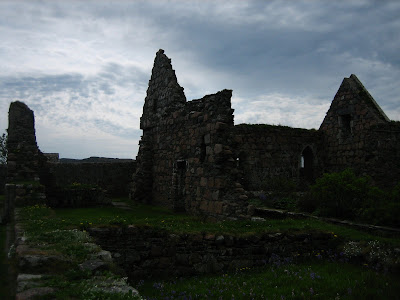
Likewise, most people think the tropics have the market cornered on white sand beaches. Not so, as any postcard from Iona, Uist, Lewis or Harris will attest. If I didn't know any better, I might think that the following picture was taken somewhere in the Caribbean, what with its clear waters and jauntily colored fishing boats. I might imagine the person who shot this photo was reclining under a ridiculously over-sized resort umbrella, sipping fruity cocktails, and enjoying the warm, head-numbing buzz that can only come from the mixing of alcohol, dehydration, and mild sunstroke. (Ah, vacay.)

Alas, I know better. There were no umbrellas on the beach--and certainly none in my drink--as it was a toasty 54 F on Iona. Normally, this is approaching the lower bound of my "Kathryn's preferred ambient temperature" range, but I made do. I own a heavy, lined sailing jacket for one reason: it's perfect for Scottish weather. Thus, I have to make frequent trips to my favorite wee country to justify owning such heavy duty outerwear.
While the mid-50s might be brisk to me, there were plenty of other metazoans that were perfectly comfortable. My favorites were the ones I found in the tide pools, like these gorgeous vermilion anemones.

At first, I wasn't sure what these tiny little Actinarians were. However, when I touched one, he retracted his little tentacles before slowly letting them unfurl once more. (For a full appreciation of just how pretty these little guys are, click the picture to enlarge.)
While I'm usually perfectly content to wander around and pester nature with my constant prodding, coastal flora and fauna were not what initially drew me to Iona. Iona has a very special history, not only for Scotland, but for most of western Europe. This small, holy island was the birthplace of Christianity in Scotland, and has held great religious significance since the 6th century. (No, that's not a typo.)
St. Columba was an Irish monk who sought to spread Christianity to the Picts that ruled most of northern Britain. In 563, he landed on the Mull of Kintyre but did not set up shop there, as the Irish had colonized much of western Scotland for centuries. Instead, he moved on to the Hebrides, finally settling in Iona, where he began work on his abbey. Although the original church was lost, the current abbey, built in the early 1200s, stands on the site of the first Columban church.

Unfortunately, the abbey was undergoing some intensive restoration, so most of my pictures are marred by scaffolding and tarps. The preceding photo shows the entrance to the nave, with the abbey's well in front. Just in front of this edifice is a towering 1,200-year-old Celtic cross carved from a three-meter block of sandstone.
Iona was important as a center of ecclesiastical learning in early Christian Europe. Monks from all over the Continent would travel to tiny Iona to study and pray with Columba and his monastic descendants. According to several sources of varying veracities, much of the Book of Kells (one of Ireland's most prized religious and historical relics) was illustrated in the abbey on Iona.

A small reading room just off the nave in the abbey. A short, narrow staircase led to a door no higher than my shoulders. Christ, people were tiny back in the days of perpetual and inescapable malnutrition. Also, holy creepy photo, Batman.
Despite the abbey's advanced age, much of the original stonework is intact. These carvings onone of the interior columns are thought to date from around 1200.

Scotland has a rich history of bloodshed and bellicosity*, so like most medieval structures in the country, the abbey has seen its share of violence. In the early ninth century, a Viking raid on the island left every resident of the abbey dead. Over the next few decades, bands of Vikings repeatedly pillaged Iona and the surrounding islands.

The cloisters of Iona, which were added several centuries after its establishment. Cloisters are my favorite part of medieval cathedrals. I think it's the symmetry and the repetition that appeal to my OCD. If only I were kidding. (Sigh.) All around the interior walls of the cloisters were the remnants of stone crosses that had adorned the site throughout its 1,500 years of service.

St. Oran's Chapel, the oldest original building standing on Iona. This small chapel dates from the mid-twelfth century, but the cemetery around it is considerably older. Further, the graveyard holds the remains of nearly 50 kings of Dalriada, one of the ancient kingdoms of Scotland.

Finally, the remains of the Iona Nunnery, built in 1203. Sadly, like many of the religious structures in Scotland, the nunnery and the abbey fell victims to the Reformation in the 16th and 17th centuries. The nunnery took the brunt of the abuse and was not restored in the same manner as the abbey.
There is plenty more to see on Iona than just the abbey and the ancient religious structures. The island itself is a beautiful patch of land in an already stunning locale. However, there is a certain tranquility in this one area of the island that is hard to recreate elsewhere. Though the summer crowds hadn't yet arrived on the island, I was far from alone when touring the abbey and the surrounding ruins. That being said, you can't help but turn inward when standing in the cloisters, the stone relief of the column cool under your hand, while the sun peeks through the cloister arches and warms your face. Iona is one of the world's magical, timeless places that leaves you not only with a better sense of history and culture, but also a better sense of yourself.
* Easily one of my favorite words of all time.

No comments:
Post a Comment